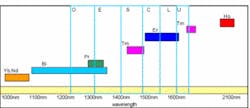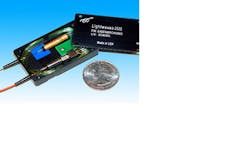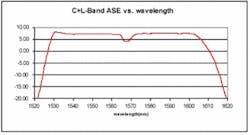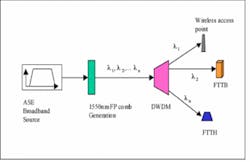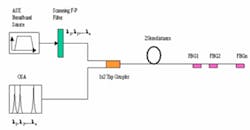FIBER SOURCES: High-power ASE tunable lasers show their colors
J.J. PAN, Z.G. HUANG, AND JAMES PANG
Amplified-spontaneous-emission (ASE) sources based on erbium and other rare-earth-doped fiber have improved in performance in recent years. Advances in output power, power density, gain flatness, wavelength range, and stability have opened the door to many new application possibilities.
A typical ASE source is optically pumped by a 980 or 1480 nm diode laser. Erbium-doped fiber works as the gain medium at C-band wavelengths of 1530 to 1565 nm (see Fig. 1). The total output power is between 10 and 17 dBm.
The working principle of an ASE source is the same as that of an erbium-doped fiber amplifier except that it does not need input signal to simulate population inversion of the erbium ion. The population in the metastable state, 4I13/2, is spontaneously attenuated to the low energy level 4I15/2, producing spontaneously emitted f radiation, which is then amplified along the erbium-doped fiber. The output is without specified wavelength and polarization, and the coherence is very low. The ASE emission spectrum is very wide due to a variety of processes that contribute to spectral broadening, such as stark splitting and thermal broadening.
Wavelength coverage
Different rare-earth dopants produce different ASE wavelength coverage ranges. The most frequently used, erbium (Er) has broadband coverage in the C-band from 1530 to 1565 nm, and in the L-band from 1565 to 1620 nm. The other well-known rare-earth elements include thulium (Tm) in the S-band from 1445 to 1510 nm and in the U-band at approximately 1700 nm (Tm-fluorides), praesodymium (Pr) in the O-band at 1280 to 1330 nm, ytterbium (Yb) and neodymium (Nd) from 1020 to 1100 nm and Holmium (Ho) near 2.1 mm. Recently, bismuth (Bi) was found to have a potential gain band exceeding 1150 to 1350 nm (see Fig. 2).1Amplified spontaneous emission sources are usually based on a counterpropagation pump scheme because the backward ASE power is higher than forward output. A 980 nm pump diode laser at 200 to 250 mW of power can produce 17 dBm of ASE output power from 1530 to 1565 nm in the C-band. Increasing the pump power or use of a multistage configuration will produce output powers from 23 to 32 dBm and higher.
Also, ASE sources using integrated components are available in compact (40 × 70 × 12 mm) and ultracompact (30 × 50 × 8 mm) sizes with output powers from 10 to 13 dBm (see Fig. 3). Because this type of compact ASE source has better stability, low coherence, and is polarization independent, it is a good candidate in sensing and gyroscope applications.An alternative approach to illuminating the sensor with a broadband light source and detecting the wavelength change using an OSA, is to illuminate the FBG sensor with a narrowband wavelength from a low-cost tunable ASE laser source and to detect the amplitude change of the reflection, significantly reducing the price of the optical sensor system.
Tunable ASE source
To validate high-power tunable ASE sources as strong competitors of chip-based tunable lasers, we conducted an experiment based on erbium-doped-fiber ASE sources and partial positive feedback. The erbium-doped fiber was pumped by a 980 nm diode laser. Then, 1% to10% of the ASE broadband output was tapped as a feedback seed, which is passed through a tunable filter and fed back to the input of the ASE source. Energy in the C-band spectrum is concentrated at the seed wavelength, resulting in a high-power, tunable, single-wavelength output (see Fig. 7).This tunable ASE laser source has numerous advantages compared with conventional tunable lasers. Because such a source can easily reach 23 dBm of output power via high-power pumping or adding multiple stages, the tunable wavelength band can be extended to the L-band from 1570 to 1610 nm, or to the C+L band from 1525 to 1610 nm. The tunable laser source has a high side-mode suppression ratio of greater than 65 dB, which is comparable to that of other chip-based tunable laser sources (at 50 to 60 dB). The output power is stable, especially in automatic power-control conditions, and the stability is better than 0.01 dB/hr.
Furthermore, the tunable ASE sources feature lower coherence than chip-based tunable laser sources and no mode-hops. The advantage of low coherence is especially useful in thin-film-coating control applications. For high-accuracy coating control and monitoring applications, especially in 0.01% to 0.001% antireflection-coating filter preparation, high output power and side-mode-suppression-ratio light sources with a linewidth from 0.05 to 0.1 nm are essential to control the thin-film thickness. Low-coherence light sources also prevent interference between light beams from reflecting off different substrate surfaces, which disturbs accurate control of the coating.
The ability to achieve a high degree of polarization is another feature of the ASE tunable source. The output can be either polarization-independent (with a polarization-dependent loss of less than 0.1dB) or 100% polarized via an inline polarizer in the feedback. It is difficult to achieve more than 15 dB of polarization extinction ratio (PER) from a chip-based tunable laser. However, ASE-based tunable sources have demonstrated more than 30 dB of PER in tests, a feature useful in polarization metrology.
REFERENCES
1. B. Dussardier, W. Blanc, Proc. Optical Fiber Conf.-NFOEC, OMN1 (2007).
2. H.J. Park et al., Proc. Optical Fiber Conf.-NFOEC, OWL1 (2007).
J.J. PAN is president and founder, Z.G. HUANG is active project engineering manager, and JAMES PANG is director of marketing and sales at Lightwaves2020, 1323 Great Mall Dr., Milpitas, CA 95035; e-mail: [email protected]; www.lightwaves2020.com.

